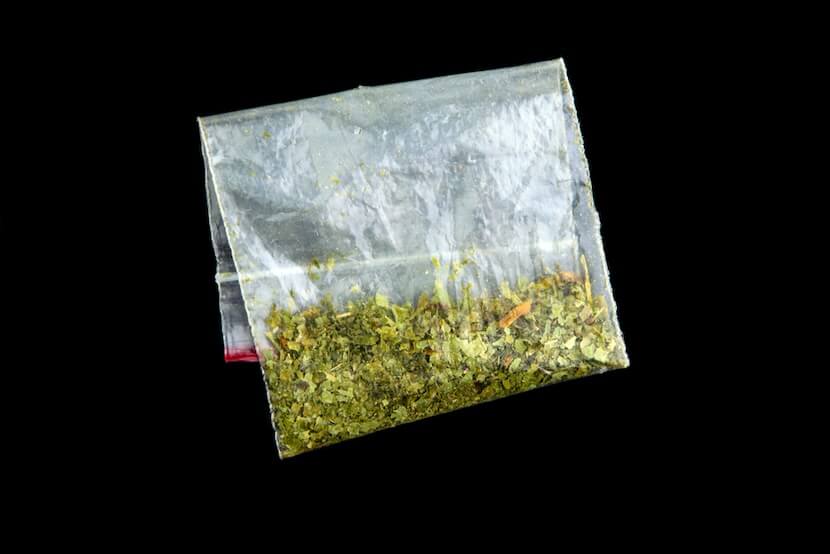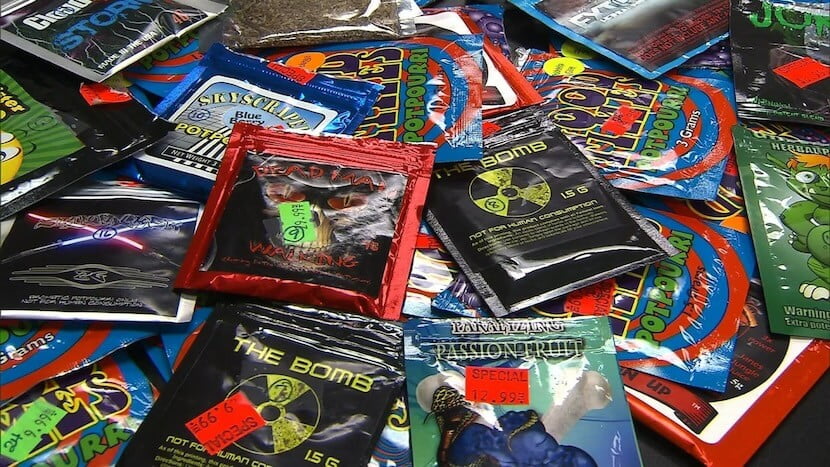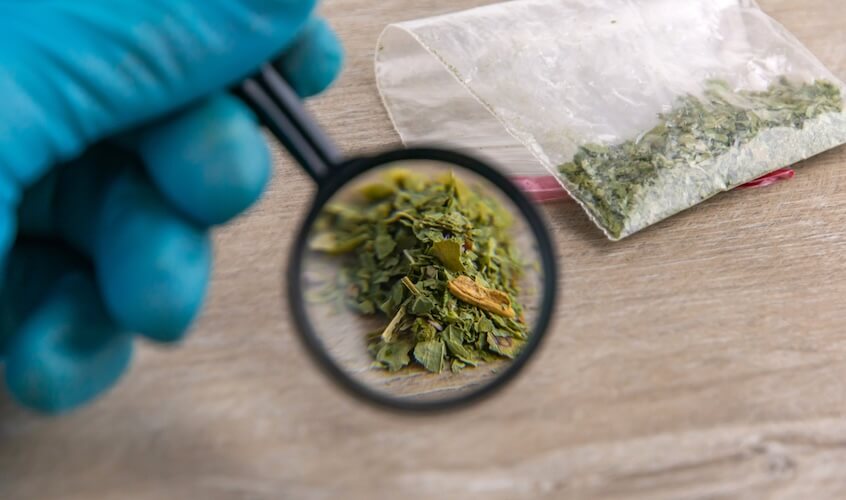When it comes to illicit drugs, you might have heard names like Bombay, Bliss, K2, Spice, and Genie. While these may sound fun and harmless, these drugs fall under the category of synthetic marijuana or synthetic weed. These products are generally marketed as stronger and safer alternatives to natural marijuana – but don’t be fooled by this facade.
Synthetic cannabinoids contain artificially synthesised chemicals that are not only illegal but the safety of which has not been evaluated in humans. This is why synthetic marijuana products pose serious dangers to health and their consumption can lead to serious side effects such as seizures, paranoia, and heart attacks. Some of these products might even contain substances such as rat poison and fentanyl which won’t be listed on the label.
Understanding what synthetic marijuana is and its health implications is very important for steering clear of these products. This article offers a complete guide to what synthetic marijuana is, why it is dangerous, addiction and rehabilitation prospects, and the laws that surround it.
What is Synthetic Marijuana?
Synthetic marijuana doesn’t refer to just one thing. It is a blend of dried plant substances coated with chemicals and sold as a so-called legal substitute for traditional marijuana. Synthetic marijuana is created to mimic the impacts of delta-9-tetrahydrocannabinol (THC), the main psychoactive component found in marijuana.
Synthetic marijuana features harmful and illicit substances that are often created in labs. These strong hallucinogens were generally sold in certain retail locations, like liquor stores and gas stations. Sometimes, these substances were available in liquid form for usage in an e-cigarette or vape pen. K2 and Spice were among the first brand names introduced. Scooby Snax, Bizarro, Mr. Nice Guy, and Red Dawn X came after.
Origin Story
In the 1960s, individuals began obtaining THC from cannabis. Later, in the 1980s and 90s, researchers developed an increased understanding of the advantages of CB1 receptors and the endocannabinoid system (ECS) and delved deeper into the cannabis plant with support from government funding.
The first synthetic marijuana compounds were manufactured in the 1980s and 1990s by scientists who were trying to develop new treatments for ailments like HIV and multiple sclerosis. However, despite many trials, their experiments did not show positive outcomes.
In the late 1990s and early 2000s, there was no proof that synthetic marijuana had any medical benefit. Simultaneously, there was a rise in the distribution of these substances, which ultimately gave rise to illegal and artificial forms of marijuana making rounds in public spaces. They first appeared as recreational drugs in Germany around 2008.
What is the Appearance of Synthetic Marijuana?
Synthetic marijuana exists as a solid or oil in its original state. After being mixed with dried herbs, vegetable material, or plant clippings, it is made to resemble actual herbal cannabis.
The smoking blends of synthetic cannabinoids come in small sachets that are usually vibrant and colourful. They also have labels that describe them as either incense or herbal smoking mixtures, and typically indicate that they are not meant for consumption by humans to distract authorities.
There are numerous branded smoking mixtures, yet it is not rare for different brands to have identical synthetic cannabinoids.

How Does Synthetic Marijuana Work Differently from Natural Cannabis?
Our body naturally contains molecules similar to cannabis known as endocannabinoids. These molecules interact with receptors in a complex system within our body known as the endocannabinoid system (ECS).
The ECS regulates many important functions in the body such as mood, memory, appetite, pain, and inflammation. The two main endocannabinoid receptors are cannabinoid receptor one (CB1) and cannabinoid receptor two (CB2).
The main location of CB1 receptors is in your brain. CB2 receptors are present in both the digestive and immune systems. Receptors are present in or around your cells. When toxins, hormones, or drugs attach to these receptors, they alter the functioning of the cells and hence the bodily processes that are associated with them.
When natural marijuana is consumed, the tetrahydrocannabinol (THC) it contains binds to CB1 receptors, leading to an overpowering of the ECS. That is the reason why individuals encounter varying impacts and the famous “high” associated with THC.
While natural marijuana also induces feelings of calmness and relaxation, it also inhibits the function of the body’s endocannabinoids on the ECS, leading to paranoia, anxiety, impaired concentration and cognition, and potential addiction.
In the case of synthetic marijuana, it binds to CB1 receptors with a higher potency and also contains harmful substances as compared to natural marijuana. This increases its strength and ability to have powerful negative impacts on the mental and physical well-being of individuals. Synthetic marijuana is also easier to overuse which results in unpleasant and harmful experiences.
What are its Adverse Effects?
Synthetic marijuana has several side effects. These drugs can cause an individual to turn aggressive, intolerant, and incoherent. These adverse effects can persist for hours and, since the strains of synthetic marijuana are regularly changing, treating these effects becomes very different.
Moreover, the adverse effects of synthetic cannabinoids also wear off more rapidly than natural cannabis. This causes individuals to use more of the drug without taking a sufficient break, increasing their chances of heightened negative effects and dependence.
The physical side effects of synthetic marijuana include:
- Nausea
- Vomiting
- Dizziness and light-headedness
- Drowsiness
- Elevated heart rate
- Hot flushes
- Excessive sweating
- Tremors
- Seizures
- Stroke
- Muscle damage
- Kidney complications
- Heart attack
The psychological adverse effects of marijuana include:
- Mood swings
- Agitation
- Anxiety
- Paranoia
- Confusion
- Delusions
- Hallucinations
- Violent behaviour
- Suicidal thoughts
- Memory problems
The long-term use of synthetic marijuana can result in severe permanent side effects, such as psychiatric issues, heart and kidney problems, and cognitive and behavioural impairments.
Is Synthetic Marijuana Dangerous?
As is obvious by now, the straightforward answer is yes, synthetic marijuana is extremely dangerous.
There have been a number of hospitalizations linked to the use of synthetic marijuana where people became sick, delusional, and even unconscious. Young adults who are hospitalised usually show signs of overdosing and exhibit violent behaviour.
Besides being extremely potent and laced with illicit drugs, here are some other reasons why synthetic marijuana is so dangerous:
- The packaging neither displays the exact drugs that are in the product nor their effects
- The active ingredients in the product are effectively random and can even vary between similar products
- It is impossible to accurately determine the quantity of drugs present in a given package since batches may contain several active ingredients which can be highly toxic when taken together.

How Does Synthetic Marijuana Affect the Brain?
As detailed previously, the THC in natural marijuana binds to the receptors in the endocannabinoid system. This can overpower the ECS and cause various side effects. Synthetic marijuana binds even more strongly to these receptors resulting in serious physical and psychological side effects that can prove to be long-term and deadly.
In addition, the structure of many synthetic cannabinoids resembles serotonin, a naturally occurring neurotransmitter that conveys messages between nerve cells in the brain and the body. Some researchers highlight the potential risk of synthetic cannabinoids overstimulating the serotonin system (known as ‘serotonin syndrome’) resulting in high fever, elevated pulse rate, excessive sweating, mood swings, confusion, seizures, organ failure, and even death.
Synthetic Marijuana Addiction
The regular use of synthetic cannabinoids can lead to dependency and addiction. Whether a person becomes addicted is based on several factors such as:
- The duration of usage
- Frequency of use
- Predisposition to dependency
- History of substance abuse
Individuals who have been using synthetic cannabinoids consistently may have trouble quitting and may face both psychological and physical withdrawal symptoms upon cessation. Withdrawal symptoms can include irritability, mood fluctuations, reduced appetite, weight reduction, sleep disturbances, sweating, trembling, and diarrhoea.
What Makes People Abuse Synthetic Marijuana?
Several factors can lead to an individual abusing synthetic marijuana.
- Synthetic cannabis is usually less expensive than real cannabis, leading to increased accessibility.
- People use synthetic marijuana to achieve the same effects as natural marijuana thinking that it will have lesser side effects and is a better alternative to actual marijuana.
- Some individuals may try synthetic marijuana out of mere curiosity in order to see how it affects them. They might desire to feel “high” or alter their mental state.
- People suffering from conditions like anxiety and depression might turn to synthetic marijuana for self-treatment. This form of utilisation is particularly concerning since synthetic marijuana has the potential to create a strong addiction, leading individuals to ultimately develop a physical reliance on the substance.
Long-term Consequences of Abusing Synthetic Marijuana
Synthetic marijuana addiction can result in various adverse outcomes.
Health Issues
The prolonged use of synthetic marijuana can lead to various physical and mental health problems such as nausea, vomiting, increased heart rate, high blood pressure, seizures, paranoia, cognitive impairment, reduced motor skills, and even death from overdose. These effects may result in disastrous outcomes such as bodily injuries, mishaps, or automobile collisions, that can be deadly.
However, it must be emphasised that any of these health issues can also occur from short-term usage since there is no safe amount of synthetic marijuana determined.
Legal Problems
Although numerous cannabinoids, such as CBD, are legal for medicinal purposes, certain synthetic marijuana substances are prohibited in certain countries, states, or cities, and individuals may face severe legal repercussions for possessing or consuming them. These substances can change an individual’s state of mind and lead to impaired judgement, like driving while intoxicated, leading to potential legal consequences.
Employment Struggles
Unfortunately, individuals facing issues with synthetic marijuana abuse are also likely to experience difficulties with employment. Using synthetic marijuana can result in decreased work productivity, frequent absences, and behavioural problems, leading to the potential loss of employment and credibility.
Relationship Difficulties
Just as with work, the misuse of synthetic marijuana can cause tension in relationships with loved ones and result in social seclusion. For many people, drug abuse results in relationships ending, marriages dissolving, and being cut off from family members.
Financial Struggles
Abusing synthetic marijuana can be costly, just like many other illegal drugs. Sustained mistreatment can result in financial difficulties, resulting in debt, homelessness, and unemployment.

Deaths from Synthetic Marijuana Use
One major difference that makes synthetic cannabinoids extremely dangerous as compared to natural cannabis is that deaths from cannabis toxicity have never been documented, while drug toxicity related to synthetic cannabinoids has caused numerous fatalities. This is mainly due to the fact that synthetic cannabinoids can be 10 to 100 times stronger than cannabis and can lead to sudden heart-related issues like heart attacks.
Furthermore, many of these fatalities happened in residences with no one present to step in or contact emergency services. Instances also included individuals abruptly falling after encountering some of the common side effects of synthetic marijuana, such as vomiting/aspiration, confusion, severe restlessness, convulsions, chest discomfort, and difficulty breathing.
Treatment and Rehabilitation
Treatment for dependence and/or addiction to synthetic marijuana typically involves a blend of pharmacological treatments and psychotherapies to target the physical and psychological aspects of the problem. Treatment varies according to the individual’s specific requirements and circumstances. Some of the most common treatment options are:
Cognitive-Behavioural Therapy (CBT)
Cognitive Behavioural Therapy (CBT) is one of the most effective treatments for substance use disorders, including addiction to synthetic marijuana. CBT assists in recognizing and altering harmful thinking and actions tied to substance abuse. Recognizing, processing, and comprehending these aspects is a crucial aspect of therapy that aids in developing coping strategies with lasting benefits beyond treatment.
Medication-Assisted Treatment (MAT)
Medication-Assisted Treatment (MAT) is a form of treatment that blends cognitive-behavioural therapies with particular medications. Drugs in this treatment are utilised to control distinct symptoms or aid individuals requiring extended periods to quit using the substance safely.
Inpatient Treatment
Those suffering from serious addiction or dependency on synthetic marijuana may be advised to participate in residential treatment programs. These programs offer an organised and nurturing setting for people to dedicate their time to recovery around the clock for a designated period.
Outpatient Treatment
Outpatient services provide drug and alcohol treatment sessions that can be attended several times per week while staying at home. This choice could be advantageous for individuals experiencing mild to moderate synthetic marijuana abuse, or those struggling to balance childcare or work while undergoing treatment.
Support Groups
Support groups are a gathering place for individuals to offer each other emotional and moral support while going through or recovering from addiction. Individuals frequently find solace in these communities as they encounter like-minded individuals and do not have to worry about facing criticism from family and friends.
Laws Concerning Synthetic Marijuana
While certain synthetic cannabinoids were once considered legal, many have since been banned. Many synthetic cannabinoids and any blends with banned substances are classified as illegal drugs and are unlawful to possess, distribute, or trade.

United States
On July 10, 2012, former United States President Barack Obama signed the Synthetic Drug Abuse Prevention Act of 2012 which banned synthetic compounds generally found in synthetic marijuana and placed them under Schedule I of the Controlled Substances Act.
United Kingdom
As of May 26th, 2016, when the Psychoactive Substances Act was implemented, it is illegal to manufacture, distribute, or bring in any form of synthetic marijuana (including online purchases) for human consumption in the United Kingdom. Moreover, the Psychoactive Substances Act now includes all psychoactive substances that were previously not covered by the Misuse of Drugs Act.
Germany
As of November 26, 2016, about 80-90% of substances categorised as synthetic cannabinoids are illegal in Germany.
Russia
On April 9, 2009, the Chief Medical Officer of the Russian Federation reinforced control over the selling of smoking blends. On January 14, 2010, the Russian government listed 23 synthetic cannabinoids found in smoking blends like Hawaiian Rose and Blue Lotus as prohibited narcotic and psychotropic substances; 780 new psychoactive substances were added to this list between 2011 and 2014. On October 30, 2014, President Vladimir Putin introduced a bill stating that the penalty for selling or consuming smoking blends could be a fine or up to eight years in prison.
Australia
Despite attempts to promote synthetic cannabinoids as legal substitutes for cannabis, they are considered illegal in Australia. States/territories have continued to adjust their laws to keep these products illegal.
The laws in effect since 2021 are:
- Outside of alcohol, tobacco and food, there is a complete prohibition on selling any substance with a psychoactive effect in Queensland, New South Wales, South Australia, Western Australia, Victoria and Tasmania.
- Commonwealth laws also prohibit any psychoactive drug not already banned by existing state and territory laws.
Japan
Japan’s Cannabis Control Law, enacted in July 1948, prohibits the import, export, cultivation, sale, purchase, and research of cannabis buds and leaves.
However, specific cannabis extracts are lawful because a loophole in regulations allows the import of products crafted from cannabis stems and stalks without THC. This has led to the popularity of synthetic cannabinoids over the past four years in Japan. However, certain derivatives and synthetic cannabinoids like HHC and CUMYL-CBMICA are illegal and prohibited, and their authorities continue to add more to the ban list.
Conclusion: Using Cannabis Safely
Synthetic marijuana products are commonly promoted as safer, more potent alternatives to organic marijuana. However, these products include synthetic chemicals that have not been researched in humans and are potentially more hazardous than perceived. Because these items are prohibited, they are not subject to regulation or testing, so they often contain unlisted contaminants that can be detrimental to health.
To steer clear of synthetic cannabinoids, always buy cannabis products from licensed dispensaries that are regulated by the state. These marijuana products have undergone extensive testing and follow strict labelling regulations. Therefore, you can rely on the fact that they only include what the label indicates.
Items purchased at unlicensed head shops, corner stores, or gas stations are at a higher risk of containing dangerous or unlawful substances. It is advisable to be cautious when buying items from places like these. If a product states it is ‘not intended for human consumption’, it’s best to avoid it completely.








Leave a Comment